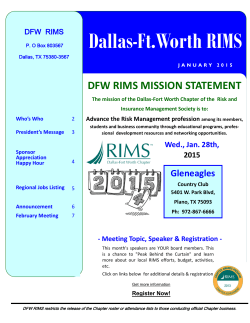
Assessment Mechanism
Ramaiah Institute of Management Studies Bangalore, India Assessment Plan I. Strategic Assessment: Mission and Broad‐Based Goals A. State the approved mission of the academic business unit. The mission of RIMS is excellence in business education. We aim to achieve this by: ¾ Developing value creating managers and entrepreneurs ¾ Encouraging and motivating faculty to engage in research that impacts society in a positive manner, and ¾ Nurturing our people to reach their potential and contribute to the welfare of humankind thus leading to sustainable development B. List the approved broad‐based goals of the academic business unit: 1. Student Learning Goals a. Leadership Skills: Graduates will posses leadership skills to include effective communication, goal setting, and the formulation and implementation of plans that are in alignment with the mission of the organization b. Critical Thinking: Graduates will constantly analyze strengths and weaknesses of the organization relative to their domain of work, monitor potential opportunities and threats in changing global environments, and proactively formulate appropriate plans to achieve competitive advantage for their organizations c. Synthesis and Integration: Graduates will synthesize relevant information from different functional areas and perform qualitative and quantitative analysis for effective problem solving and decision making d. Business context: Graduates will identify the significance of ethical, social, technological, demographic, and economic factors, and incorporate their findings into business processes for effective and efficient problem solving and decision making e. Continuous Improvement: Graduates will understand and implement continuous improvement as a philosophy and apply it to their personal and professional development, as well as to the organizations’ success 2. Operational Goals a. RIMS will offer contemporary and forward looking graduate programs that prepare students for professional careers, higher education, and entrepreneurship b. RIMS will attract and retain talented faculty who are effective teachers and are engaged in research, consulting, training, outreach or other professional development activities c. RIMS will provide a supportive learning environment that fosters student success and contributes to excellence in business education d. RIMS will offer hands‐on, experiential learning opportunities for students through a mid‐program internship, live projects, and an end‐of‐program comprehensive dissertation based on work carried out in an organization II. Student Learning Assessment A. Articulate program‐level intended student learning outcomes for each business program: 1. Students will be able to communicate effectively with different levels of personnel using both oral and written formats for different purposes 2. Students will be able to establish, validate and secure support for organizational goals 3. Students will be able to formulate and implement plans that are feasible, effective, and understandable to achieve organizational goals and social responsibilities 4. Students will be able to perform a comprehensive analysis of organizational strengths and weaknesses, as well as environmental opportunities and threats 5. Students will be able to develop and implement action plans to achieve competitive advantage for the organization 6. Students will be able to comprehend the “Big Picture” view as well as the “Detailed View” of business 7. Students will understand and appreciate dependencies between functional areas 8. Students will use quantitative and qualitative tools that synergize organizational performance in problem solving and decision making 9. Students will consider ethical issues when making decisions to achieve individual and organizational responsibilities within a broadly defined ethical framework 10. Students will consider the implications of cultural, economic, ethnic and other forms of diversity while making decisions 11. Students will ensure that individual and organizational decisions are aligned and are within the relevant legal and regulatory mechanisms and requirements 12. Students will anticipate and adapt to changes in the business context and environment 13. Students will develop strategies, action plans and process improvements and organizational practices for long term sustainability and competitive advantage 14. Students will strive to become global citizens with a deep and abiding concern for the less privileged B. Identify measures of student learning that will be used to assess the program‐level intended student learning outcomes: Sl. No. Direct Measures of Student Learning Performance Targets / Criteria for Direct Measures 1 IVY SOLUTIONS – POST MBA TEST (MAJOR FIELD TEST) At least 80% of graduating MBA students will score at the 75 percentile or higher on each Assessment Indicator (Accounting, Finance, General Management, Marketing, Human Resources and Business Strategy) 2 CAPSTONE – INTEGRATED DISSERTATION At least 80% of graduating MBA students will achieve a “Mastering” or “Exceeding” rating on each learning‐related dissertation evaluation criterion th Sl. No. Indirect Measures of Student Learning Performance Targets / Criteria for Indirect Measures 1 NOEL‐LEVITZ STUDENT SATISFACTION INVENTORY At least 80% of graduating students will indicate a score of 5 or better on a 7‐point scale as to their having achieved the intended learning outcomes 2 EMPLOYER SATISFACTION SURVEY At least 80% of recruiting employers will score 5 or better on a 7 point scale as to their satisfaction with the students’ skills and competencies C. Specify performance targets/criteria for each measure of student learning that will be used to determine the extent to which the program‐level intended student learning outcomes are being achieved. 1. Mapping of Intended Student Learning Outcomes to Broad‐Based Student Learning Goals Broad‐based Student Learning Goals Intended Student Learning Outcomes Leadership Skills Critical Thinking Synthesis and Integration Business Context Continuous Improvement Effective Communication × Goal Setting × Formulate and Implement Plans × SWOT Analysis × Action Plans for Competitive Advantage × Comprehend “Big Picture” and “Detailed View” × Understand Functional Dependencies × Tools for Synthesizing Performance × Ethical Behavior × Apply CAGE framework × Align with legal and regulatory requirements × Anticipate and Adapt to Changes × Long‐term Sustainability and Competitive Advantage × Sensitized Global Citizens × 2. Mapping of Assessment Measures to Intended Student Learning Outcomes The direct and indirect measures of student learning provide for the assessment of the program’s entire intended student learning outcomes. These relationships are summarized in the measures‐to‐outcomes mapping below Graduate Level Programs Intended Student Learning Outcomes Dissertation Noel‐Levitz SSI Employer Satisfaction Survey Communication × × Goal Setting × × × Planning and Implementation × × × SWOT Analysis × × × × Action Plans × × × Perspective × × × Functional Dependencies × × × Synergy × × × Ethical Behavior × × × CAGE Framework × × × Alignment × × × Adaptation to Change × × × Long‐term Sustainability × × × × Sensitized Global Citizen × × × MBA Assessment Measures Independent Post‐MBA Test 3. Mapping of Direct Assessment Measures to Key Learning Outcomes: Master’s Level Programs For each master’s level program, the direct measures of student learning provide for the assessment of the “Key Learning Outcomes for Business Programs” as identified by the IACBE. These relationships are summarized in the measures‐to‐key‐outcomes mapping below: Master’s Level Programs Key Learning Outcomes MBA / PGPM Direct Measures of Student Learning IVY SOLUTIONS POST‐MBA TEST DISSERTATION Problem Recognition Skills × × Strategic Analysis and Integration Skills × × Ability to apply quantitative methods to real‐world business situations × × Ability to communicate to relevant publics ‐ Effective Written Communication Skills × × ‐ Effective Oral Communication and Presentation Skills × Team Work Skills × Ethical Obligations, Responsibilities and Behavior × III. Operational Assessment A. Articulate intended operational outcomes for the academic business unit. Intended operational outcomes for RIMS: 1. RIMS will ensure that graduating students are placed in appropriate executive positions in leading organizations 2. RIMS will facilitate graduating students desirous of becoming entrepreneurs by assisting them in preparing project reports and identifying venture capitalists and angel investors 3. Students will graduate from RIMS in a timely manner 4. RIMS’ faculty will comprise of appropriately qualified – academically and/or professionally – scholars in their respective disciplines 5. RIMS’ faculty will constantly benchmark with best practices and ensure that students receive high quality instruction and guidance 6. RIMS will provide effective academic counseling to its students whenever such advice is required 7. RIMS will provide state‐of‐the‐art technological backbone and knowledge resources to its students 8. RIMS’ faculty will adopt innovative approaches to the teaching‐learning process 9. The programs offered by RIMS will be contemporary, relevant, and effectively meet the needs of business 10. RIMS will provide adequate opportunities to students to gain hands‐on experience through internships, live projects and an end‐of‐program dissertation B. Identify measures/methods that will be used to assess the intended operational outcomes. Assessment Measures for Intended Operational Outcomes Annual Report of the Career Development Office MBA Alumni Survey Faculty Credentials Faculty Development Faculty Performance Student Exit Survey Student Exit Survey Student Exit Survey Student Exit Survey Student Exit Survey Performance Targets/Criteria for Operational Measures RIMS will place at least 90% of its graduating students desirous of being placed in leading organizations within 3 months of their graduation On the survey instrument, at least 90% of alumni will indicate a “Satisfied” or “Highly Satisfied” level about their academic and professional training received at RIMS At least 90% of RIMS’ full time and adjunct faculty members will be either academically and/or professionally qualified to teach in their respective disciplinary areas At least 75% of RIMS’ full time faculty will attended at least two professional development programs each year. Programs could include Faculty Development Programs, conferences related to their disciplines, seminars, workshops, or certification programs Effective the calendar year 2012, at least 75% of RIMS’ faculty will publish at least one scholarly paper in a journal of repute every 2 years. Alternative accomplishments include presenting reviewed papers at international conferences, writing test books in their disciplines, and developing cases specifically suited to the Indian context On the N‐L Student Satisfaction Inventory, at least 80% of the graduating students will indicate a score of 5 or better on a 7‐point scale with regard to teaching effectiveness On the N‐L SSI, at least 80% of graduating students will indicate a score of 5 or better on a 7‐point scale with regard to academic counseling services On the N‐L SSI, at least 80% of graduating students will indicate a score of 5 or better on a 7‐point scale with regard to knowledge resources and technological environment On the N‐L SSI, at least 80% of graduating students will indicate a score of 5 or better on a 7‐point scale with regard to the creativity and innovation of their programs in the classroom On the N‐L SSI, at least 80% of graduating students will indicate a score of 5 or better on a 7‐point scale with regard to the currency and relevance of the curriculum that they went through C. Specify performance targets/criteria for each measure/method that will be used to determine the extent to which the intended operational outcomes are being achieved. Mapping of Intended Operational Outcomes to Broad‐Based Operational Goals The broad‐based operational goals identified in Section I encompasses the intended operational outcomes as articulated in this section, and are general composites or summaries of the outcomes. These relationships are summarized in the outcomes‐to‐goals mapping below: Broad‐based Operational Goals Intended Operational Outcomes RIMS will ensure that graduating students are placed in appropriate executive positions in leading organizations RIMS will facilitate graduating students desirous of becoming entrepreneurs by assisting them in preparing project reports and identifying venture capitalists and angel investors Students will graduate from RIMS in a timely manner RIMS’ faculty will comprise of appropriately qualified – academically and/or professionally – scholars in their respective disciplines RIMS’ faculty will constantly benchmark with best practices and ensure that students receive high quality instruction and guidance RIMS will provide effective academic counseling to its students whenever such advice is required RIMS will provide state‐ of‐the‐art technological backbone and knowledge resources to its students RIMS’ faculty will adopt innovative approaches to the teaching‐learning process The programs offered by RIMS will be contemporary, relevant, and effectively meet the needs of business RIMS will provide adequate opportunities to students to gain hands‐on experience through internships, live projects and an end‐of‐ program dissertation RIMS will offer a contemporary and forward‐looking graduate programs that prepare students for professional careers, higher education and entrepreneurship RIMS will attract and retain talented faculty who are effective teachers and are engaged in research, training, outreach or other professional development activities RIMS will provide a supportive learning environment that fosters student success and contribute to excellence in business education RIMS will offer hands‐on experiential learning opportunities for students through internships, live projects, and a comprehensive end‐of‐ program dissertation × × × × × × × × × × × IV. Linkage of Outcomes Assessment with Strategic Planning Just before the commencement of the academic year (usually July), each department of RIMS meets and conducts a gap analysis between intended outcomes and actual outcomes – both learning and operational. Based on the gap analysis, benchmarking with the “best” schools, and focus group interviews with customers (internal‐students, external‐employers), the departments prioritize the areas to be addressed and the method of bridging the gaps. Action plans are drawn up that articulate (a) what will be done (b) who will do it (c) who will measure the results (d) when will it be done (timelines) (e) what will it cost (resources) and (f) what is sought to be accomplished at the end of the cycle of implementation (quantifying desired results). Since RIMS offers graduate programs only and the size of the school is relatively small, the Department Chairs along with the Academic Dean and the Chief Academic Advisor draw up the institutions’ strategic plan for the following academic year. The strategic plan is presented to the Academic Governing Council of the institution. The Council comprises of practitioners, academics, the top management, department chairs and student representatives. The Academic Council (a) reviews and if necessary revises the institution’s mission, broad‐based goals and core values (b) reviews, revises (if necessary) and approves the strategic plan (c) reviews, revises (if necessary) and approves the environmental analysis carried out by top management and department chairs (d) approves the action plans, timelines and resource requirements and (e) sets guidelines for continuous improvement. Following the Academic Council meeting, and the directions issued thereof, the Chief Academic Advisor and the Academic Dean prepare a detailed budget as well as an assessment and planning report. This report ensures that all activities and initiatives are aligned to the mission of the institution and the broad‐based goals. Typically, the time horizon for the report is 3 years, with an overarching goal for 3 years and detailed steps for each year, carried out on a rolling basis. The results of the Academic Council meeting along with the report prepared by the Chief Academic Advisor and the Dean are discussed with the Founder‐Director and placed before the institution’s Governing Council for final approval. The Council comprises of CEOs of corporations, leading academics and representatives of faculty and staff. The approved plan is the basis for action and the process is repeated at the beginning of the following year.
© Copyright 2025









